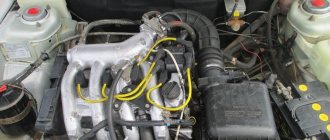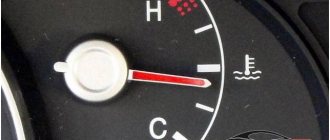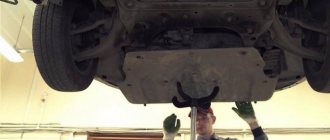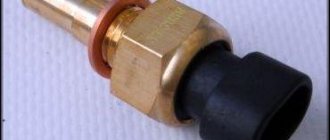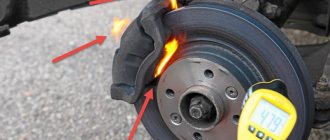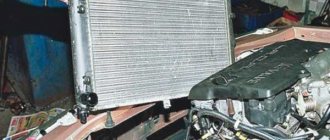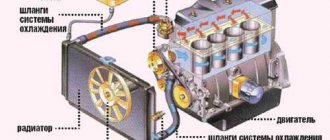Engine operating temperature on a Lada Granta car should be 90 degrees, but most owners complain that the temperature does not rise above 80 degrees. Even despite the above-zero temperature outside.
Apparently AvtoVAZ decided to further protect itself by installing a thermostat that opens already at 85°. The most interesting thing is that AvtoVAZ defines the tolerances for the opening temperature of the thermostat as: (85±8.3) ºС, i.e. from 77 to 93 ºС
. This is a scatter, isn't it?
The operating temperature of the engine must be at least 90ºС.
To learn how to find out the engine temperature when your car is not equipped with a temperature indicator on the instrument panel, read the material: how to check the engine temperature.
Motor temperature
It turns out that the temperature regime in which internal combustion engines operate depends very little on the ambient temperature. To a greater extent, this indicator is influenced by the design, as well as the operating features of a particular unit.
From a design point of view, motors are distinguished by the cooling method, design, type of fluids used, materials, compression, presence of supercharging, operating speed, and level of wear. So, in each individual case the operating temperature of the engine is different. There are also quite a lot of factors that influence the regime.
High temperatures are very harmful to any motor, regardless of its design. Therefore, you need to maintain the correct temperature regime.
What temperature sensors are installed on the Lada Granta, where are they located and the price
Now let's see what devices are installed on Russian cars and where they can be found.
- Lada Granta engine coolant temperature sensor is installed in the thermostat cover - 300 rubles;
- detonation device at the front of the cylinder block wall. Between the second and third;
- the device for determining the location of the crankshaft is found in a special opening in the tide of the oil pump cover;
- device for determining phases or camshaft - 2000 rubles;
- air and pressure measuring device;
- lambda probe - 1000 rubles;
- device for calculating mass air flow - 1800 rubles;
- device for determining speed - 310 rubles;
- oil pressure.
Attention! Experienced mechanics do not recommend buying equipment on open markets. It is best to make purchases in specialized stores or service centers.
Catalog items
The serial number for the engine temperature gauge of a vehicle from a domestic manufacturer is 2190-94. It is not being repaired. Experienced mechanics advise checking this device before replacing it. At the service center, the procedure is carried out at special stands. But you can check it at home.
The role of cooling in creating a favorable temperature regime
The operating temperature of the engine depends on the efficiency of the cooling system. It is a complex of all devices that supply coolant to technological areas and then remove heat to the atmosphere.
The purpose of the coolant is to provide the most favorable conditions for the functioning of engines. And also so that when working in any conditions, the temperature regime is maintained at the same level. When the fuel burns, the temperature at this moment is about 2000 degrees. And the cooling system allows you to reduce it to 90 degrees. This is considered the optimal temperature.
Design Features
By default, the 11186 engine retains all the design features of the original 21114, from which it originated:
- volume 1.6 l;
- the block height is 2.3 mm greater than that of 2110;
- crankshaft with an increased crank radius by the same 2.3 mm (piston stroke 75.6 mm, respectively);
- ShPG, flywheel and crown from 2110.
In addition, a feature for the 11186 engine is the bending of the valves on the pistons when the timing belt drive breaks:
- the piston skirt is reduced here to make it lighter;
- It is physically impossible to make a deep hole for the valve inside the piston.
The manufacturer's manual contains a description of the components and parameters of the internal combustion engine, which are most often compared with the characteristics of the 11183 engine, which has the most similar markings. The main differences between these power drives from the same manufacturer are:
- torque is 15 Nm more;
- power 87 l. With. instead of 82 l. With.;
- motor 11186 has been produced since 2011, and its predecessor 11183 since 2004;
- instead of serial pistons from 2110 weighing 350 g, a lightweight version 21116 weighing 240 g is used;
- connecting rod length increased from 121 mm to 133.32 mm;
- the piston skirt has a graphite coating, the metal in the area of the first ring is anodized;
- combustion chamber 30 cm3 instead of 26 cm3;
- compression ratio increased from 9.6 to 10.5;
- The cylinder head gasket is all-metal, its thickness has been reduced from 1.2 mm to 0.43 mm;
- the cylinder head is 1.2 mm higher to compensate for the enlarged combustion chamber;
- the diameter of the bolts was reduced from M12 to M10 to reduce cylinder deformations during tightening;
- the flow channels in the cylinder head have been increased in diameter, nozzles have been installed to cool the piston heads;
- the working chamfer under the valves is maintained longer due to the strengthening of the aluminum alloy using a special technology;
- since the holes in the pistons are not enough to ensure the safety of the valves, a high-strength timing belt from the Gates manufacturer is used;
- the camshaft V-belt received an automatic tensioner, which had not previously been used in VAZ engines;
- the piston system is protected externally from overheating by a cooling jacket integrated into the cylinder block;
- the length of the receiver channels has been increased, the characteristics of the internal combustion engine are close to those of a 16 valve engine;
- the catalytic collector has a flattened block, which made it possible to separate the ducts and get rid of power losses and turbulence;
- the generator is mounted on a bracket, so its drive belt is not overtightened, like 11183, and lasts longer;
- The cabin heat exchanger and expansion tank are included in the thermostat in parallel, the operating error has decreased to 2 degrees instead of 5 degrees.
Timing belt cover 11186 on the right, improved design
On the right is the catalytic collector 11186 with a rational exhaust circuit
Modified generator mounting unit
New thermostat design
According to the AvtoVAZ plant, the ICE 11186 has a potential of 120 hp. (without resource reduction) or 180 l. With. (the resource will be reduced due to intensive wear of the piston). The manufacturer recommends tuning exclusively through modifications of components and mechanisms without the use of turbines.
Why is overheating dangerous?
If the engine gets very hot, this can ultimately lead to dire consequences for the car owner. Overheating leads to increased wear of parts and components.
If the motor has been running for a short time at high temperatures, then there is nothing to be afraid of. Nothing will happen to him in 5 minutes. The reasons for this are various malfunctions with the fan or incorrect operation of the thermostat. If you stop the car in time, the maximum consequences are melting of the pistons. For a new car, short-term overheating is not at all scary.
If the engine operating temperature exceeds the norm for about 20 minutes or more, then there is a serious risk of cylinder head deformation and gasket burnout. Inter-ring partitions may also become unusable.
If the engine is completely overheated, this is a real disaster. This leads to damage to every part, every unit. The motor could even explode if the components were a little more reliable. If there is severe overheating, the piston group will certainly melt, and liquid metal will fall on the cylinders. This will make the piston stroke much harder, which means more wear. Also, engine diagnostics after overheating often reveals inevitable problems in the operation of the lubrication system. Overheated oil will not have its original properties, and rubbing vapors will destroy themselves. Pistons can puncture the cylinder head, and the crankshaft often breaks in two.
Advantages and disadvantages
The main advantage of the motor is the fact that the manufacturer has already managed to increase the power to 64.2 kW. In addition, it is possible to boost the motor without loss of service life. That is, the owner will not have to make major repairs more often than scheduled.
The disadvantages of ICE 11186 are:
- “meeting” of the piston with the valve in the event of a break in the timing belt drive;
- periodic valve adjustment;
- non-repairable ignition unit.
The advantages of the engine in comparison with the existing versions of the internal combustion engine of the AvtoVAZ manufacturer at the time of its creation are:
- do-it-yourself overhaul after the piston group has reached the end of its service life at least 3 times using different repair kits;
- increased volumes of combustion chambers;
- built-in piston cooling system;
- the hinged one is secured with brackets and has automatic tensioners;
- modernization of the cylinder head and crankshaft;
- piston and crankshaft relief;
- use of parts from existing engines.
Therefore, during repairs and tuning there are no problems with spare parts and components. Maintenance is cheaper than foreign-made engines.
What causes engine overheating?
In most cases, the engine heats up in the summer. But similar cases are also observed in winter and autumn. The reasons can be very different. Overheating can be external or internal.
External overheating can be determined by the increase in temperature of the cooling mixture. The driver can notice this and react immediately. And when the engine heats up from the inside, it is difficult to notice right away. The high temperature remains inside the engine, the coolant temperature does not increase. And the unit suddenly loses power.
The first reason is the lack of cooling mixture in the system. Liquid may leak from the system due to depressurization. Engine cooling in modern cars consists of many different pipes, pipes, clamps, and gaskets. A leak can happen anywhere. Leaks can be easily diagnosed. These are white spots or streaks on the outer parts of the motor. This includes drops of liquid under the car after parking. But the leak is nonsense. It's worse when the coolant goes into the lubrication system. There is a risk of getting a water hammer or - even worse - a jammed crankshaft.
The second reason is ineffective cooling of the radiator. There are several possible problems here. If the fan is not electric, but is powered by the crankshaft, then it is worth checking the belt tension. If the airflow is electric, then problems should be looked for in the thermostat. Another culprit is the engine radiator. Dirt easily gets into its ribs and it becomes clogged. This can be diagnosed if the temperature returns to normal slightly after parking.
Malfunctions in the thermostat also lead to overheating. Various deposits accumulate in the cooling system, and this leads to deterioration in the performance of the elastic element of the thermostat. It simply no longer records the temperature of the coolant mixture. If it is installed in one position, it will pump the mixture in a large circuit or in a small one. The thermostat also really doesn’t like the effects of our hard water.
How effectively the cooling will work depends on the level of coolant flow that is pumped through the system. Its consumption depends on the crankshaft speed. But it’s summer, it’s hot, it’s a highway. There is a long and serious climb ahead and a KamAZ. It is impossible to overtake him due to oncoming traffic. The internal combustion engine is boiling. And why all? There is no speed, the air flow is weak, the speed is low, cooling has virtually no effect, and the engine operates in hard mode despite the fact that the optimal operating temperature of the VAZ engine is 90 degrees. Everything is here at once.
There are other reasons, but these are the most popular.
Lada Granta engine cooling system: malfunctions and methods for eliminating them
The cooling system maintains a certain temperature inside the engine by removing excess heat generated as a result of fuel combustion in the cylinders. During operation, parts can become very hot. Without heat removal, the engine will overheat and collapse.
Elements of the Lada Granta cooling system
On Lada Granta cars with an injector, a closed liquid ODS with forced circulation of antifreeze is used. It removes heat and acts as a lubricant and does not freeze in severe frosts in winter. In a working system, the temperature of the Lada Granta engine is maintained at 95-100 degrees. Regardless of the body type, configuration, or the presence of air conditioning, the cooling system remains the same, without any changes.
Thus, a recall program has started in Russia to return 145 Bentley Continental GT cars. All models were released in 2018-2019. The recall is due to an issue related to insufficient battery voltage, which can cause the center console switch assembly to fail.
The list of VIN numbers of cars that are subject to recall is published on the Rosstandart website. Moreover, each owner will receive an official letter, according to which they need to provide the car to official dealers for repair work.
During the repair process, dealers will update the center panel switch assembly program or replace the assembly. All work will be carried out at the expense of the manufacturer. After the repairs are completed, the cars will be returned to the owners, with the necessary documents completed confirming the fact that the repairs were completed under the car recall program.
Dealers will not need much time to complete repair work, so owners can wait for their cars in the waiting room.
Recently, legendary cars “from the past” have been put up for sale in various parts of the world - well-known sports cars in factory configuration and in perfect condition.
Of course, the question is: how did such legendary cars survive to this day? Because they look as if time and years have passed them by.
Nissan Skyline GT-R Nismo, 1990. Up for auction in America. For this rare car, they are asking relatively little, just some 820,000 rubles. But since this car is up for auction, its price could undoubtedly increase. By the way, this example is for sale in the same form in which it left the assembly line: the 2.6-liter engine is still capable of producing 280 horsepower, and the appearance is not at all spoiled. Only a couple of changes - lowered suspension, a new exhaust pipe and the absence of rear axle steering.
Toyota Supra, 1997 release. By the way, this anniversary version is black, has a removable roof panel and is in exactly the same perfect condition as the previous example. But only its price is also “anniversary” - during the auction it flew up to 11,227,000 rubles! Someone is really in love with this car and wants to buy it. By the way, it is also up for auction in the States.
Buick GNX, 1987 release. And again we are pleased with the decent condition. Inside, you can note that the interior is still wrapped in factory wrap, and the tires are still filled with air from 1987. We can say that there is no mileage at all - 79 kilometers. 3.8-liter turbocharged engine with a power of 300 hp, rich finishing and power accessories. And the price tag is modest - only 4,514,000 rubles. The ad was posted in America.
Porsche 911 Strosek, 1977. The appearance of the car is still from that era - small front optics and streamlined wings have long become the hallmark of this car. As for the area under the hood, it is filled with a luxurious 2.7-liter six-cylinder engine with Strosek additions. The condition of the body is as if the car had just been picked up from the assembly line. Amazing!
Lotus Esprit Turbo, 1983. Compared to the above cars, this “James Bond car” is being auctioned for a relatively small amount - 1,175,000 rubles. The car is in good condition, 2.2 liter engine with a five-speed manual transmission. By the way, this car is one of the limited editions, as only 50 pieces were produced. This example is for sale in Ohio.
ZAZ-968 A, manufactured in 1977. Exhibited not in the states, but here, in Russia. It sells today for a very substantial amount, but it's worth it. According to the seller, this car has been in the garage for about 30 years, so its mileage is low, and the body has never felt any rust.
Bottom line. If you are a connoisseur of iconic cars, and your finances allow you to purchase something similar, then take the time to spend a little time searching for ads on the Internet. Perhaps luck will smile on you and you will find a car in good condition.
The driver and the car have been together for almost 150 years. And during this time, automobile statistics have managed to accumulate interesting facts. Some of them arouse curiosity, while others make you think.
About the number of cars. Automotive companies are actively developing production. This has led to a bit of an oversaturation of cars in the world. Today the indicators are:
- The total number of cars on the planet is about 1 billion.
- Daily vehicle production is at 165,000 units.
- The number of parts to assemble a machine is about 30,000 positions.
From the life of a car. Despite all the love for his car, not every driver has a caring attitude towards his car. Although there are exceptions:
- about 95% of the time the car is in use is parked or in a garage;
- 75 of the 100 Rolls-Royce badged cars produced are still in service;
- the highest mileage by car during its life was recorded at 4,586,063 thousand kilometers;
- in the United States, the average owner spends $8,876 a year on maintaining one vehicle—over 50 years, that’s almost $0.5 million;
- in Turkmenistan from 2008 to 2014, each driver received 120 liters free of charge every month. fuel.
Highly dangerous product. Over time, the car has turned from a comfortable means of transportation into a source of environmental danger. On the roads, in the hands of a careless driver, it is also a source of danger to life and health for passengers and pedestrians. No less interesting facts are revealed here:
- At the beginning of the century, mechanical carriages were more environmentally friendly transport compared to horse-drawn carriages.
- Up to 50 odors of various organic compounds were detected in a new car.
- An American driver spends up to 38 hours in traffic jams throughout the year.
- The first traffic accident with a car was recorded in the US state of Ohio in 1891.
- Currently, the risk of dying in a car accident is estimated at 1:5000.
- About 40% of drivers do not have time to press the brake pedal moments before an accident on the road.
- According to traffic accident statistics in the United States, road accidents are the No. 1 cause of death for young people under 35 years of age.
- In many countries around the world, sounding the horn is permitted only to prevent accidents.
- A seat belt with 3 attachment points was patented by Volvo. Access to the right to use the development was made free of charge. Today, a seat belt saves someone's life every 6 minutes.
Other interesting facts.
-There are more and more cars in the world. In Los Angeles, America, there are already more cars than people. Moreover, they win not only by numbers.
— The fastest production car reached a speed of 431 km/h. It was a Bugatti Veyron with the Super Sport prefix. If you go at this speed to the Moon, it will take only 1 month and 7 days for the entire journey.
Bottom line. The era of fossil fuel cars is coming to an end. Perhaps electric cars will bring their own records and new historical facts.
Not just overheating...
In addition to overheating, there is also hypothermia. But this does not harm the engine components as much. Often this phenomenon occurs due to low temperature outside the car. In a supercooled unit, the oil thickens and has weak lubricating properties. This is the reason for increased wear. Hypothermia also causes fuel to enter the crankcase. As fuel flows, it washes lubricant off important parts. There is increased wear of the piston and cylinder group. With all this, the engine loses its power.
Information letter AvtoVAZ (excerpt)
Excerpt from the “Information letter to AvtoVAZ dealers.”
4.3 Owners of cars of the Lada Granta (2190) and Kalina FL (2192, 2194) families state a fact: the average coolant temperature on their current cars is 7–10 degrees lower than on the previous Priora, Samara and Kalina models. Due to subjective “unusuality”, this fact has been elevated by consumers and service station personnel to the rank of a discrepancy (defect) called “underheating” of the engine.
4.4 Maintaining the coolant temperature on cars of the Lada Granta (2190) and Kalina FL (2192, 2194) families in the temperature range below the “usual” ones on previous car models Priora, Samara and Kalina does not lead to increased fuel consumption, increased wear of engine parts and no other negative consequences. Accordingly, in the absence of negative consequences and the absence of a coolant temperature standard, “underheating” of the engine according to clause 4.3 is not a non-compliance (defect).
4.5 A consumer’s claim for non-conformity (defect) “underheating” of the engine should not be accepted by service station personnel unless it is accompanied by a consumer complaint about any additional associated negative manifestation. If an unfounded claim is rejected, the consumer must be explained the features of the engine cooling system of cars of the Lada Granta (2190) and Kalina FL (2192, 2194) family.
That's the point of the whole guarantee! Rivet the cars from the beginning with defects, and they all went through the woods! Explaining this by saying that this is a design feature of the car's cooling system.
I have the same nonsense
The temperature does not rise above 80, even in the city or on the highway. I even put cardboard in the radiator, so I understand that it’s not just me who does this?
Yes, my engine temperature on Kalina was 85 87 from the beginning. The time has come to replace the thermostat, now the temperature does not rise above 80. It seems to say everything is fine, but it seems to me that now it has started to take oil. Not because the temperature has become lower.
If overheating occurs
When your engine suddenly overheats or your cooling system suddenly stops working, the following actions can prevent catastrophic consequences.
If you can park safely on the side of the road, park right next to the curb and turn off the engine. As soon as the engine temperature arrow has left the danger zone, and the temperature is in optimal values, you can continue driving.
To help your unit return to normal faster, it is better to open the hood. This way the heat can escape very quickly. You should do this extremely carefully - there is a risk of getting burned.
There is no need to attempt to open the radiator cap. If you open it, steam and coolant will come out of the radiator. It is under pressure - you could be seriously injured.
How to fix breakdowns
Repair of ODS elements is not considered as part of troubleshooting. In most cases, replacement of failed parts is necessary.
Replacing the thermostat
Lada Granta is available with two types of engines: one of them is 8-valve, the other is 16-valve. The location of the thermostat on these power plants is somewhat different, which means that replacement is carried out with certain differences.
To replace the thermostat on an eight-valve engine, you will need a small set of tools: socket wrenches, screwdrivers, a Torex wrench and a container for draining the coolant.
The replacement procedure is simple; to do this, you need to follow a number of steps:
- Place the car on a level surface and use a jack to raise the front end.
- After unscrewing the bolts securing the engine protection, remove it.
- Place a suitable container under the plug to drain the coolant from the radiator.
- Unscrew the cap from the expansion tank neck.
- Unscrew the drain plug and wait until the liquid drains.
- Loosen the thermostat pipe clamp from the rear and disconnect the hose.
- Loosen the clamp on the front thermostat pipe and disconnect it.
- The ground wire is secured with a nut on the thermostat stud - unscrew it and disconnect the wire.
- Unscrew both nuts that secure the thermostat to the studs and remove it.
- Remove the O-ring and, unscrewing the three nuts, remove the thermostat cover.
- Press and rotate the locking plate to remove the cover.
- Remove the spring with the valve mechanism.
Installing a new thermostat is carried out in the reverse order. If the hoses will not be changed, then to prevent possible leakage of antifreeze, it is recommended to lubricate them from the inside with a small amount of sealant before installation.
After installing the thermostat, all pipes are tightened with new clamps, and coolant is poured into the expansion tank.
Then you need to start the engine and check the operation of the cooling system, if necessary, remove the air lock. To replace the thermostat on a 16-valve engine, the same set of tools is used, steps for an 8-valve engine are repeated from 1 to 6, then the process is as follows:
- Disconnect all pipes through which coolant is supplied to the thermostat by loosening the clamps.
- Unscrew the fastening bolts and remove the thermostat cover from the seat.
- Remove the sealing ring, turn the fixing plate by pressing and remove the spring with the valve mechanism.
Installation of a new thermostat is carried out in the reverse order. All hoses are connected, antifreeze is poured into the system, the engine is started, and if necessary, the air lock is removed, after which antifreeze is added to the tank to the mark between the minimum and maximum. There are many fakes and low-quality parts on the car parts market, so it is advisable to check the thermostat before installation. To do this, you need to heat water in a container to a temperature close to boiling and place a thermostat there; if the valve begins to open slightly, it means the device is working.
Replacing the thermostat can be done with your own hands in a regular garage. There are no difficulties, but you will have to spend money on a new part, pipes, if changed, and coolant. To save time, you can contact any car service center, where within 20-30 minutes the technicians will change the thermostat for 200-300 rubles.
Replacing the coolant pump
To replace the pump on a Grant you will need a set of sockets, wrenches and screwdrivers. Many car owners combine pump replacement with timing belt replacement. At the initial stage, the process is identical for both procedures:
- Disconnect the negative terminal from the battery.
- Using a 17 mm wrench, rotate the camshaft pulley by the fastening nut until the mark on the pulley matches the mark on the rear casing cover. So the piston in the first cylinder will be at top dead center.
- The nut securing the timing belt tensioner roller is unscrewed and the tension is weakened.
- Drain the coolant through the drain hole on the radiator.
- Unscrew the bolts securing the pump to the cylinder block and remove it together with the sealing gasket.
- The new pump must be installed with the number facing up, and it is recommended to replace the sealing gasket.
Next, installation of the belt and pulleys (if the timing belt has been changed) is carried out in the reverse order. In this case, you need to ensure that the marks are not knocked down, otherwise the valve timing will be disrupted.
A car service center will charge from 800 to 1,500 rubles for such work, depending on the type of engine (8 or 16 valves).
How to repair an expansion tank
During engine operation, the expansion tank is constantly deformed from increasing and decreasing pressure in the system, as well as from temperature changes. Over time, the material wears out, and at peak pressure, microcracks form on the walls. In most cases, no one repairs this part - the tank is replaced. But there are also those who try to repair it with their own hands. The material from which the tank is made is incompatible with most adhesive bases, so it will not be possible to seal it. For repairs, you can use two available methods:
- soldering with a soldering iron using metal reinforcing mesh;
- repair cracks with epoxy resin or cold welding.
Compositions based on epoxy resins and similar substances act temporarily, so for high-quality repairs it is recommended to solder the tank. The crack site is thoroughly cleaned with fine sandpaper, degreased and dried. A thin metal mesh is placed over the hole and a continuous layer is sealed into plastic with a soldering iron.
The treated area is cleaned, puttied and, if necessary, primed and painted. The car service center does not do such things and offers to replace a cracked tank - the cost of the service is no more than 200 rubles.
Connecting hoses, electric fans and radiators should be replaced if they fail. The latter can be soldered, but no one is responsible for the quality, since the process is labor-intensive and requires equipment and experience. Considering that soldering costs about 800 rubles, then it is more logical to purchase a new radiator.
What should I do to restore normal engine temperature?
The first step is to check the amount of coolant. If there is not enough fluid in the tank, it needs to be added. Modern cars have plastic tanks. They have markers by which you can evaluate the level.
If there is no tank in the car, then you should not immediately pour water into the radiator. There is a risk of serious burns. It is also worth checking the cooling system for leaks. It would be a good idea to inspect the radiator. As well as engine diagnostics if it has suffered serious overheating.
New instrument panel
On a Lada Granta with a new instrument panel, the temperature indicator should already be built-in. However, not all cars have it. Therefore, many car owners have to reflash the panel.
Since overheating alarms are no longer installed, the temperature should be displayed on the instrument panel when requested by the car owner. If it is not there, then perhaps the manufacturer installed old firmware and therefore the car owner cannot find the engine temperature on the instrument panel screen.
The instrument panel also displays other values of vehicle parts. For example, gasoline consumption, amount of gasoline, errors in operation of the automatic transmission or engine.
Warm-up process
The unit can be considered sufficiently warmed up when all components, mechanisms and fluids reach operating temperatures. The cooling mixture is heated first. This can be seen by the arrow. It also heats the piston-cylinder group. The oil heats up much more slowly. Owners of those cars that are equipped with on-board computers may have noticed that after reaching the operating temperature, fuel consumption, even if the engine is idling, may decrease. This is due to the slow heating of the oil.
Specifications
Lada Granta cars were equipped with both 8 and 16 valve engines. As practice has shown, the latter justified the trust of consumers, since they used less fuel and did not break down so often.
Let's consider the main technical characteristics of the engines that were mounted on the Lada Granta with a 16 valve head:
VAZ 21126
| Name | Characteristic |
| Brand | 21126 |
| Marking | 1.6 16V |
| Power | 98 horsepower |
| Type | Injection |
| Fuel | Petrol |
| Valve mechanism | 16 valve |
| Number of cylinders | 4 |
| Fuel consumption | 7.5 liters |
| Piston diameter | 82 mm |
| Resource | 180 - 200 thousand km |
VAZ 21127
| Name | Characteristic |
| Brand | 21127 |
| Marking | 1.8 16V |
| Power | 106 l. With. |
| Type | Injection |
| Fuel | Petrol |
| Valve mechanism | 16 valve |
| Number of cylinders | 4 |
| Fuel consumption | 8.2 liters |
| Piston diameter | 82 mm |
| Resource | 200 - 250 thousand km |
Certain death
Only the lazy did not write that wear increases when starting and warming up the engine. But driving a car without pre-warming does not allow all parts, assemblies, and bearings to prepare for the loads.
The piston has side grooves for piston rings. These grooves are very sensitive to heavy loads. They are easily destroyed when doing this. And at the start without warming up, such loads are felt.
Maintenance
In accordance with the manufacturer's regulations, engine 11186 must be serviced in the following order:
Timing belt3/50Battery1/20Valve clearances2/20Crankcase ventilation2/20Belts driving attachments2/20Fuel line and tank cap2/40Motor oil1/10Filter (oil)1/10Filter (air)1 – 2/40Filter (fuel)4/40Fittings and hoses heating/cooling 2/40 Coolant 2/40 Oxygen sensor 100 Spark plugs 1 – 2/20 Exhaust manifold 1This is exactly the frequency of maintenance that the ICE 11186 device is designed for.

